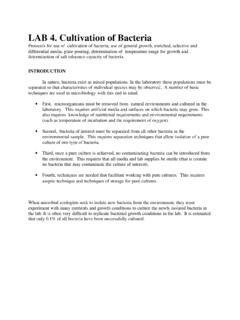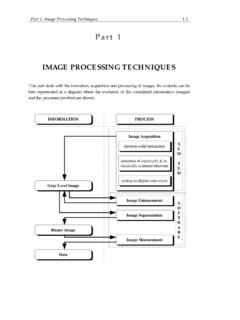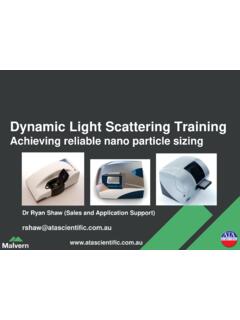Transcription of Properties of Light - University of Maryland College of ...
1 Properties of Light Waves, particles and EM spectrum Interaction with matter Absorption Reflection, refraction and scattering Polarization and diffraction Reading foci: pp 175-185, 191-199 not responsible for boxes and EM Wave EM waves are generated by vibrating electrons Composed of two perpendicular oscillating fields Can be characterized by its frequency, which is inversely related to wavelength (f = c / ) Shares with sound the Properties of spreading loss, attenuation, reflection, refraction, and diffraction, but can travel in vacuum Electromagnetic spectra High frequency EM acts like a particle, can split atoms Low frequency EM acts like a wave ROY G BIV Light waves Complex Light (sunlight) Single wave = monochromatic Light Coherent Light (in phase) = laser Polarized Light Interaction with matter All molecules have resonant frequencies at which they trap particular EM wavelengths Long wavelength EM (radiowaves)
2 Is not absorbed by biological materials Short microwaves increase atomic motion, especially water, and create heat Infrared radiation also increases atomic motion of some molecules and is perceived as heat Pit vipers and vampire bats have IR sensors Shortest x-rays and cosmic rays destroy molecules Energy in visible Light is absorbed without damage to cells Special molecules (visual pigments) make use of changes in electron orbital states Absorption by water depends on wavelength Absorption vs propagation of Light If Light wave frequency = molecules resonant frequency Light is absorbed (propagation is stopped) Medium is opaque If Light wave frequency molecules resonant frequency Light is reradiated and propagated forward through medium Medium is transparent In a solid or liquid, propagation is in straight line In a gas, propagation is less organized and scatter increases Speed of Light depends on media Medium Speed (m/s) Refractive index Vacuum 3 x 108 Air x 108 Water x 108 Glass x 108 Diamond x 108 Speed of Light is slower in water than in air (opposite to sound) Light reflects and refracts air water When 2nd medium has slower speed, Light refracts towards normal Refraction Large angle causes internal reflections air water Receptor cell Lenses focus Light Far and near sightedness Reflectance Diffuse (dull, matte) Specular (shiny)
3 Scatter depends on wavelength Intensity of scattering = constant / wavelength4 Blue is scattered more than yellow Sun is yellow, sky is blue Polarized Light Polarized Light indicates solar position Monarch butterflies can use polarized Light to orient Flight direction of tethered butterflies Measuring Light intensity Irradiance is total amount of Light incident on a surface Includes scattered Light Measured with a 180 lens (photographic Light meter) Radiance is Light emitted from specific area Measured with tube over area of interest Must specify angle of measurement Both measurements can be made wavelength-specific by filtering out other wavelengths A series of measurements creates an irradiance or radiance spectrum (in wavelengths) Radiance spectra example (courtesy of Karen Carleton) Metriaclima zebra gold Absorption depends on frequency Water absorbs red faster than blue Refraction depends on frequency Refraction causes rainbows Light Diffraction Propagation of Light through a slit demonstrates wave Properties .
4 Cancellation and addition of diffracted waves results in striped pattern in contrast to what would be expected by particles. Why Light works for visual communication Can be absorbed without damage to cells Most abundant wavelengths Reflects off solid objects Higher and lower frequencies pass through or bend around Straight-line transmission without scatter Permits formation of spatial maps Refraction at the boundary of two media Permits focusing and image formation by an eye behind a lens Frequency dependent effects influence colors









